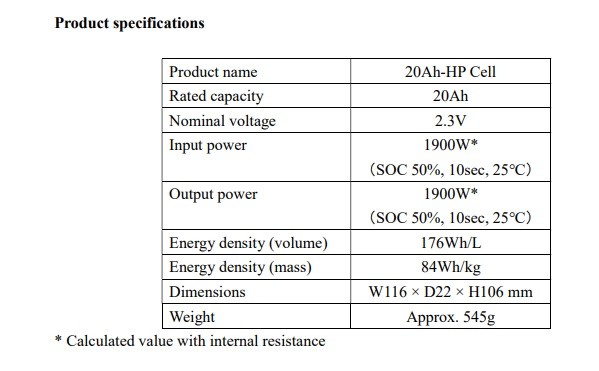On January 12, Toshiba Corporation of Japan launched a 20Ah-HP rechargeable lithium-ion battery that can provide high energy and high power at the same time, expanding its SCiB product range.

(Image source: Toshiba)
There is a general need for rechargeable lithium-ion batteries that can provide both high energy and high power, but until now it has not been possible to provide both. For example, in electric vehicles , high energy batteries can greatly increase the range of electric vehicles, but they reduce power input and output and increase charging time. With its expertise in high energy and high power products, Toshiba has developed a new battery that can achieve both performances.
The new battery is suitable for heavy-duty applications that require high power input and output, and situations where the battery must suppress heat and operate continuously, such as fast charging of commercial vehicles, regenerative power systems for rolling stock and industrial equipment.
The battery is the same size as Toshiba’s current 20Ah product, allowing existing customers to easily upgrade to improved input and output power using the same module set. The battery is currently available for order worldwide.
The product features are as follows:
Excellent heat suppression. Compared to Toshiba's current 20Ah battery, the new 20Ah-HP battery reduces battery resistance by approximately 40%, providing 1.7 times higher input and 1.6 times higher output, thereby effectively suppressing heat generation when large currents are applied, allowing for the design of a simpler cooling system. For example, water cooling can be simplified to forced air cooling, or forced air cooling to natural cooling, depending on the customer's system. Lowering resistance also reduces overvoltage, enabling the battery to operate over a wider range of state of charge (SOC).
Ultra-long service life. Due to its lower resistance, the new 20Ah-HP battery suppresses heat during continuous charge and discharge, thus having a longer service life than the existing 20Ah battery. Under the test conditions shown in the figure below, the battery cell can maintain nearly 100% of its capacity after 8,000 charge and discharge cycles, while the capacity of the existing 20Ah battery has dropped by about 10%.

(Image source: Toshiba)
Compatibility. The new 20Ah-HP battery has improved input and output power, but is the same size as the existing 20Ah battery, allowing existing customers to easily upgrade to the improved performance using the same module set.
Toshiba expects the new battery to be deployed in automobiles, industrial equipment and storage battery systems, such as drive power and emergency power for railways, port cranes, electric ferries, hybrid buses, trucks, regenerative power for hybrid electric vehicles (HEV) and plug-in hybrid electric vehicles (PHEV), replacements for lead-acid batteries and storage battery systems.

(Image source: Toshiba)
Previous article:University of Michigan develops new lithium-sulfur battery that can be cycled 1,000 times
Next article:CATL's patent for negative electrode-free metal battery technology is exposed, achieving 200Wh/kg sodium-ion battery
- Popular Resources
- Popular amplifiers
- Breaking through the intelligent competition, Changan Automobile opens the "God's perspective"
- The world's first fully digital chassis, looking forward to the debut of the U7 PHEV and EV versions
- Design of automotive LIN communication simulator based on Renesas MCU
- When will solid-state batteries become popular?
- Adding solid-state batteries, CATL wants to continue to be the "King of Ning"
- The agency predicts that my country's public electric vehicle charging piles will reach 3.6 million this year, accounting for nearly 70% of the world
- U.S. senators urge NHTSA to issue new vehicle safety rules
- Giants step up investment, accelerating the application of solid-state batteries
- Guangzhou Auto Show: End-to-end competition accelerates, autonomous driving fully impacts luxury...
- Intel promotes AI with multi-dimensional efforts in technology, application, and ecology
- ChinaJoy Qualcomm Snapdragon Theme Pavilion takes you to experience the new changes in digital entertainment in the 5G era
- Infineon's latest generation IGBT technology platform enables precise control of speed and position
- Two test methods for LED lighting life
- Don't Let Lightning Induced Surges Scare You
- Application of brushless motor controller ML4425/4426
- Easy identification of LED power supply quality
- World's first integrated photovoltaic solar system completed in Israel
- Sliding window mean filter for avr microcontroller AD conversion
- What does call mean in the detailed explanation of ABB robot programming instructions?
- Europe's three largest chip giants re-examine their supply chains
- Breaking through the intelligent competition, Changan Automobile opens the "God's perspective"
- The world's first fully digital chassis, looking forward to the debut of the U7 PHEV and EV versions
- Design of automotive LIN communication simulator based on Renesas MCU
- When will solid-state batteries become popular?
- Adding solid-state batteries, CATL wants to continue to be the "King of Ning"
- The agency predicts that my country's public electric vehicle charging piles will reach 3.6 million this year, accounting for nearly 70% of the world
- U.S. senators urge NHTSA to issue new vehicle safety rules
- Giants step up investment, accelerating the application of solid-state batteries
- Guangzhou Auto Show: End-to-end competition accelerates, autonomous driving fully impacts luxury...
- 2SC5047 transistor
- Communication example between two nodes of SM32W108 wireless RF module
- Several Commonly Used Data Files and Their Reference Simulation in ADS
- EEWORLD University Hall - A robot that can type
- This week's highlights
- Introduction to wiring arrangement between printed circuit board components
- Sensitivity of automotive electronic logos in high and low temperature environments
- Temperature and humidity monitoring system based on ZigBee-WSN
- 【CC1352P review】——by cruelfox
- Market segments raise new challenges for power management

 BA10324AKN-E2
BA10324AKN-E2











 京公网安备 11010802033920号
京公网安备 11010802033920号